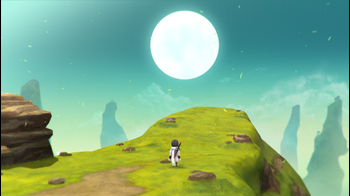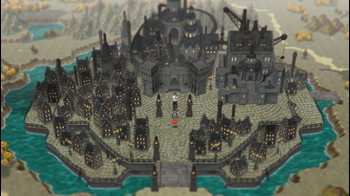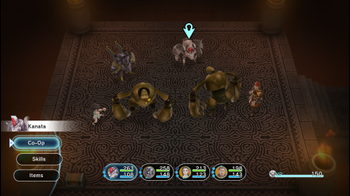
Lost Sphear Review
Lost Sphear represents the sophomore attempt from Tokyo RPG Factory, a team of passionate RPG fans focusing on different ways to bring the genre back to its roots. While I Am Setsuna presented some fascinating concepts, you could argue it didn't leave a lasting impression (even if I happened to personally love it).
Truth be told, Lost Sphear takes a lot of its inspiration and design choices directly from I Am Setsuna, which is itself an inspired game. Everything from the in-game menus to the battle screen is all presented in that same simplistic manner - a throwback to simpler times of the genre where we weren’t bogged down by a clogged user interface. You could say the entire game is rather straightforward, so allow me to explain what I mean.
The story begins with a king who tragically witnesses the destruction of his kingdom by a robotic force called the Plated People. After pushing back the remaining enemy forces on his own, a mysterious white light swallows up the land.
Before we can find out what exactly is going on, a young man named Kanata wakes up from his slumber. It turns out he has been having recurring nightmares where the same sequence plays over and over. But it seems that same white light phenomenon soon blankets his own land of Gaiterra, including his hometown. Kanata and his friends, Lumina and Locke, must now journey to find a way to learn what the source of this opaque stigma is and find out how to lift it.
While I Am Setsuna portrayed a rather somber mood throughout its narrative, Lost Sphear tries to at least find moments to pull back on this feeling through the use of humorous and entertaining moments. The only real downside is that the stakes don't start off that high, so it can be difficult to feel emotionally invested with what's happening early in the game. This is especially true when compared to I Am Setsuna where right at the beginning you’re dealing with serious matters of life and death while also dealing with an elemental threat to the lands.
Getting back to the story mechanics, at certain moments during dialog with important characters, you can extract memories from the conversation. Every so often, a word or phrase is highlighted in blue, and when you hold down a button, you absorb a person’s memory and carry it like an item. From there, you “Restore the Lost” using memories taken from people, objects, and places, to piece everything back together. This is a power only Kanata himself can wield.
This aspect of reconstructing memories and objects plays a very important role in the plot of Lost Sphear as it will help you revive the land itself. While this all may seem confusing at first, things start to make more sense especially as it nears the climax. In fact, that's exactly when everything comes together, so you'll need to have a degree of patience with the storytelling devices.
While it may not win any rewards for the best graphics, Tokyo RPG Factory was once again able to nail the style it was going for with its cohesive visuals. For example, the character models are more expressive and imbue far more detail than before - they have actual feet, for one.
And for those who weren’t thrilled with I Am Setsuna only being set in a winter tundra will be happy know Lost Sphear explores a wider variety of locations and climates. Unfortunately, although you won’t have to deal with snow, your progress around the world map is still gated with the aforementioned white light.
This same charm carries over to the soundtrack. Rather than once again relying on the breadth of piano-driven tracks as with its predecessor, this game focuses instead on more contemporary compositions that still give a person that warm sense of nostalgia. I should mention there is yet again no voice track outside of combat (which can be toggled on or off), so don’t go into this expecting that to change.
Lost Sphear's battle system distinguishes itself with a far more dynamic presentation when compared to its prior incarnation. Before you fully carry out an action, you can move a blue silhouette around the field of combat. This lets you choose where you want your character to end up after the sequence is finished. Your attack range is represented by a red field so you can line yourself up just right. Be careful, as you’re also making yourself vulnerable to an enemy’s area of attack. Each character’s attack area is shown differently. You even have the opportunity to hit multiple enemies when positioned correctly. This throws a nice dose of strategy into the folder in case you want to set up combo attacks or move away from an area of danger.
The Momentum Mode mechanic from I Am Setsuna also makes a return. For those unfamiliar with the system, allow me to explain. Around each character’s portrait at the bottom of the screen is a blue gauge that fills up with a successful attack or when you take damage. Once the gauge is filled, a character will earn a Momentum Charge (or MC) presented as a blue orb next above the health bar with a maximum of three MCs. These charges can be activated by pressing a button once a blue flash appears during a character’s attack animation. Activating Momentum Mode during an attack will increase the amount of damage dealt.
So yes, Momentum and even spritnite (imbued stones that grant you the ability to use magic) are carryovers from I Am Setsuna, though the spritnites have a few more use-cases such as being used for counterattacks.
While the parallels are not unwelcome, outside of the ability to plan your attacks ahead of time with a movable avatar, the battle system remains largely the same. I will say it becomes far more enjoyable later on in the game when you unlock the bigger combination attacks. Those were fun in the I Am Setsuna, and they are still enjoyable here. One fun new feature is that of Vulcosuits - this game's equivalent of Magitek Armor or robot suits, which are just great to look at and fight with.
Let me go back to my original comment at the top of this review. It really pleases me that I am able to navigate the game's many systems without feeling overwhelmed in the process. It is clear the developers want to continue doing everything in their power to make these games as approachable as possible without insulting the intelligence of their player base. You’re not bogged down with menu tutorials, which makes the design direction all the more convenient.
Speaking of which, another one of the more welcoming features is the ability to rewind through dialog. The dialog boxes appear over the heads of the ones who spoke, allowing you to quickly get a refresher on the current scene if you get distracted or needed to step away from the controller. There’s even a button you can press to bring up party chat to speak to other members of the group while also giving you a reminder of where to go if you’re feeling lost.
While these both may seem like minor features, they are perfect examples of how the little things work together to make this such a charming experience.
Sure, you can tell Lost Sphear was made on a tight budget, but in my eyes, some of the best work can come from working with these types of constraints. For those who grew up in the 80s and 90s, it’s a real treat to play a game like this in 2018 without having to deal with the more archaic frustrations from that period. While I would have liked it if Tokyo RPG Factory took a bigger risk with their next project, Lost Sphear still represents a more innocent and pure era for RPG Fans - at least from the player’s perspective.
Thanks to its whimsical soundtrack, interesting script, enjoyable combat system (even if most of it is copied from I Am Setsuna), there’s plenty of aspects found in Lost Sphear that I fell in love with. Whether you’re a seasoned veteran of the genre or a newcomer looking for something accessible, you should give this one a try. Just expect nothing mind-blowing.


